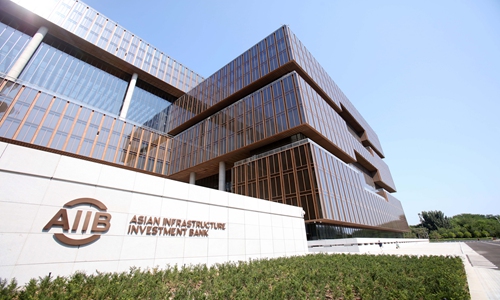
The new site of AIIB headquarters near the Olympic Forest Park in Beijing Photo: cnsphoto
China continues to integrate into global value chains (GVCs), and can capitalize on a higher participation rate in these GVCs to hasten its recovery from the COVID-19 pandemic, according to the 2021 Asian Infrastructure Finance (AIF) report released by the Asian Infrastructure Investment Bank (AIIB) on Wednesday.
China's economy is undergoing a fundamental transformation, and by continuing to maintain economic openness and links with global supply chains despite headwinds, it can contribute greatly to regional economic growth and prosperity, said Erik Berglof, chief economist of the AIIB, during an online seminar on Wednesday.
China's GVC exports as a share of total exports - the GVC participation rate - increased from 37.9 percent in 2000 to 44.6 percent in 2019. The change implies that China is moving toward a more upstream position in GVCs, in line with the transition to becoming a global supply hub in GVC networks, read the report.
Among China's GVC exports, the contribution of high-tech manufacturing increased significantly, pointing to a sign of its upgrading.
China's GVC participation rate continued to rise in 2021. But the specific value needs to be calculated, Zhao Changwen, president of the Center for International Knowledge on Development (CIKD), said on Wednesday during the seminar.
Zhao noted that industry chains emphasize the global division of labor, and supply chains focus more on efficiency and security, while the value chain is more about interest distribution. The three chains should be viewed in a comprehensive way.
"Targeting activities that will decarbonize and green its supply chain will offer the greatest potential to strengthen China's competitiveness for the future," said Berglof.
Analysts at the seminar said that China has also helped build advanced infrastructure in many developing countries.
China's potential demand has allowed developing economies to catch up all over the world. Developing countries should invest in infrastructure to see the opportunities that the rise of China has provided, said Jang Ping Thia, principal economist and manager of the Economics Department of the AIIB.
Within two decades, China will likely have the largest middle class in the world, larger than the US and EU combined, he noted.
Xin Xiuming, vice chairman of the China International Contractors Association, said that infrastructure can accelerate the participation of developing countries in the global industry and supply chains, and the idea of infrastructure connectivity for unimpeded trade of the Belt and Road Initiative aims to accelerate this process.
Xin said that infrastructure contracts signed by the association from January to October reached $172.5 billion, up 3.6 percent year-on-year.
"China's infrastructure projects are mainly developing in Asia, Africa and Latin America, after facing political obstacles when they moved into developed countries," Xin said.
By promoting an open world economy and increasing imports through large events such as the China International Import Expo, China has made real contributions to the world, Bu Wentao, director of the Investment Division of the Policy Research Department, Ministry of Commerce, said on Wednesday.
Global Times




